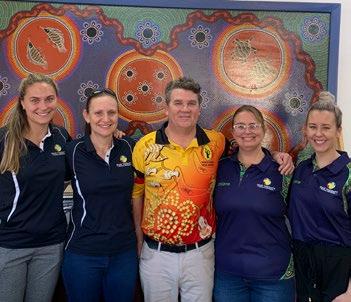
4 minute read
Professional Practice & Standards Update
Carol Jewell,OTA Acting National Manager, Professional Practice and Development
Occupational therapists working in regional, rural and remote Australia have a uniquely challenging and rewarding role supporting their communities (Boshoff and Hartshorne, 2008, Pidgeon, 2015). Typically, these communities have higher rates of hospitalisations, mortality, injury and poorer access to, and use of, primary health care services compared with those in metropolitan areas (AIHW, n.d.). Many of these communities have also experienced the devastating and lasting impacts of extreme weather—events that test the core of communities and the health and wellbeing of locals.
What is it like working in regional rural and remote Australia as an occupational therapist? What are the opportunities, what are the challenges, and what is a typical day like? Reflections and Kathy Luke and Katrina Pacey, Co-Directors RAR Therapy relatively new, and the best form of contact I invited Kathy Luke and Katrina Pacey to share their thoughts, insights and experiences of regional, rural and remote practice. Ms Luke and Ms Pacey are codirectors of RAR Therapy and long-time friends. They have more than 20 years of experience working as occupational therapists, and have a passion for reaching out to people living in regional, rural and remote (RRR) Queensland.
Insights from the Heart of Australia
Thankful for Qantas Link still operating amidst COVID-19 restrictions to reach our rural, regional and remote communities
In 2013, Rural and Regional Therapy Services formally began in the small country town of Ayr, one hour south of Townsville.
Our dream to reach out to people of all ages living in RRR areas began more than 20 years ago as occupational therapy students sitting on the bank of the Brisbane River after a day of university lectures. We were talking about our RRR student placement experiences and noted the need for better support for occupational therapists living and working in RRR areas.
This was a time when computers were Here’s what they have to say.
with other therapists was by calling on a landline (as mobile phones were rare, expensive brick-like packs). This was also a time when there was no NDIS funding, and people with disabilities were being moved from larger institutions into much smaller, supported and funded group homes in the community. Since the more recent introduction of the NDIS scheme, we have been excited at the increase in the opportunities for occupational therapists to reach people living in RRR areas. As occupational therapists, we are often at the front line, seeing people with significant challenges for the very first time—people who have been getting by and struggling with minimal or no funding, supports or equipment their whole lives. Commonly, living in old, raised homes built on stumps (to avoid floods and snakes).
In these areas, home modifications have often been made by nonbuilder family/friends, of the kind that make occupational therapists cringe at how unsafe it may be (but at the same time have been working for the person). One example was a husband who was so proud to show us the wooden ramp he had just handmade so his wheelchairbound wife could get in and out of their house. With a doorway set one metre off the ground, the ramp was steep (under 1:5 gradient), narrow, with no sides, and “gets a bit slippery when it rains”. Having a clear understanding of the nature and challenges of rural, regional and remote practice goes a long way to increasing the resilience of occupational therapists who choose this career path. The broad nature of our role provides exciting opportunities to see and experience variety unparalleled in urban centres. Being immersed in a close-knit community, and working with vibrant personalities who run the local businesses and tough it out on the farms that feed our nation, also brings rich flavour to the hard work and steep learning curve of an occupational therapist. Isolation, lack of ready support, scarce opportunities to attend

Liz Haberley and Kathy Luke: Long road trips made more fun when shared with fellow therapists training events, and expectations of service beyond knowledge and skill are some of the drawbacks to choosing rural practice. Being prepared to take action to reduce the impacts of the challenges can set up a rural therapist to thrive and develop skills beyond what they could in a city hospital or a busy paediatric clinic. To succeed in rural practice, therapists need to be ready to:
Reach out to other therapists either digitally or in a nearby hospital or community health centre to set up networks Join OTA’s MentorLink program Reconnect with colleagues from university or previous experience Plan ahead to organise PD opportunities Find a supervisor to guide your development Regularly review articles and keep a journal of how this changes your practice Maintain a weekly reflection to keep track of what changes you can make
With the right support and a passion for learning, rural practice brings fast learning and expedited development of both experience and skill. It is a challenge worth pursuing!
References
Australian Institute of Health and Welfare (AIHW) (n.d.) Rural and Remote Health Web Report 22 October 2019, retrieved from www.aihw.gov.au/reports/rural-remoteaustralians/rural-remote-health/contents/summary Boshoff, K., and Hartshorne, S. (2008), Profile of Occupational Therapy Practice in Rural and Remote South Australia, Australian Journal of Rural Health, 16(5), 255-261 Pidgeon F. (2015), Occupational Therapy: What Does this Look Like Practised in Very Remote Indigenous Areas?, Rural and Remote Health 2015, 15:3002, available from www.rrh.org.au/journal/article/3002






